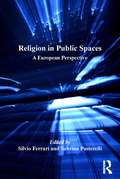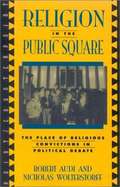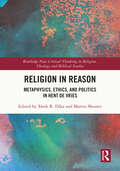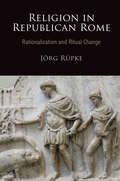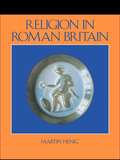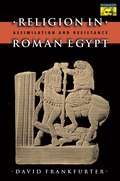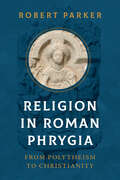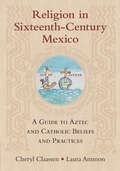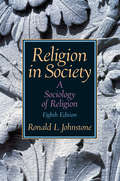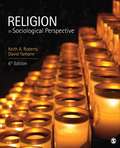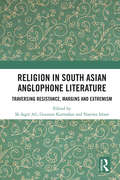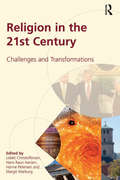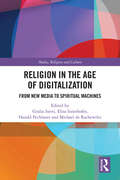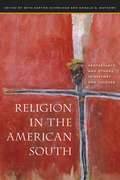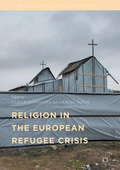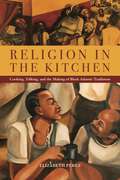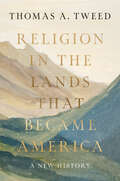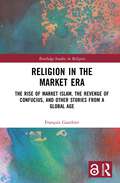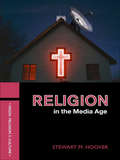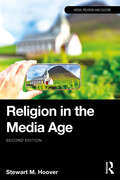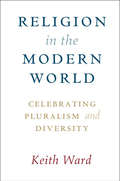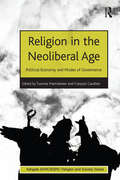- Table View
- List View
Religion in Public Spaces: A European Perspective (Cultural Diversity and Law in Association with RELIGARE)
by Silvio FerrariThis timely volume discusses the much debated and controversial subject of the presence of religion in the public sphere. The book is divided in three sections. In the first the public/private distinction is studied mainly from a theoretical point of view, through the contributions of lawyers, philosophers and sociologists. In the following sections their proposals are tested through the analysis of two case studies, religious dress codes and places of worship. These sections include discussions on some of the most controversial recent cases from around Europe with contributions from some of the leading experts in the area of law and religion. Covering a range of very different European countries including Turkey, the UK, Italy and Bulgaria, the book uses comparative case studies to illustrate how practice varies significantly even within Europe. It reveals how familiarization with religious and philosophical diversity in Europe should lead to the modification of legal frameworks historically designed to accommodate majority religions. This in turn should give rise to recognition of new groups and communities and eventually, a more adequate response to the plurality of religions and beliefs in European society.
Religion In The Public Square: The Place Of Religious Convictions In Political Debate (Point/Counterpoint #No. 94)
by Robert Audi Nicholas WolterstorffThe relation between religion and politics is a perennial concern of political philosophy, but it has never been more important than it is now. Separation of church and state is being widely challenged and vigorously debated.
Religion in Reason: Metaphysics, Ethics, and Politics in Hent de Vries (Routledge New Critical Thinking in Religion, Theology and Biblical Studies)
by Tarek R. Dika Martin ShusterThis book presents critical engagements with the work of Hent de Vries, widely regarded as one of the most important living philosophers of religion. Contributions by a distinguished group of scholars discuss the role played by religion in philosophy; the emergence and possibilities of the category of religion; and the relation between religion and violence, secularism, and sovereignty. Together, they provide a synoptic view of how de Vries’s work has prompted a reconceptualization of how religion should be studied, especially in relation to theology, politics, and new media. The volume will be of particular interest to scholars of religious studies, theology, and philosophy.
Religion in Republican Rome
by Jorg RupkeRoman religion as we know it is largely the product of the middle and late republic, the period falling roughly between the victory of Rome over its Latin allies in 338 B.C.E. and the attempt of the Italian peoples in the Social War to stop Roman domination, resulting in the victory of Rome over all of Italy in 89 B.C.E. This period witnessed the expansion and elaboration of large public rituals such as the games and the triumph as well as significant changes to Roman intellectual life, including the emergence of new media like the written calendar and new genres such as law, antiquarian writing, and philosophical discourse.In Religion in Republican Rome Jörg Rüpke argues that religious change in the period is best understood as a process of rationalization: rules and principles were abstracted from practice, then made the object of a specialized discourse with its own rules of argument and institutional loci. Thus codified and elaborated, these then guided future conduct and elaboration. Rüpke concentrates on figures both famous and less well known, including Gnaeus Flavius, Ennius, Accius, Varro, Cicero, and Julius Caesar. He contextualizes the development of rational argument about religion and antiquarian systematization of religious practices with respect to two complex processes: Roman expansion in its manifold dimensions on the one hand and cultural exchange between Greece and Rome on the other.
Religion in Roman Britain
by Mr Martin Henig Martin HenigApart from Christianity and the Oriental Cults, religion in Roman Britain is often discussed as though it remained basically Celtic in belief and practice, under a thin veneer of Roman influence. Using a wide range of archaeological evidence, Dr Henig shows that the Roman element in religion was of much greater significance and that the natural Roman veneration for the gods found meaningful expression even in the formal rituals practised in the public temples of Britain.
Religion in Roman Egypt: Assimilation and Resistance (Mythos: The Princeton/Bollingen Series in World Mythology #133)
by David FrankfurterThis exploration of cultural resilience examines the complex fate of classical Egyptian religion during the centuries from the period when Christianity first made its appearance in Egypt to when it became the region's dominant religion (roughly 100 to 600 C.E. Taking into account the full range of witnesses to continuing native piety--from papyri and saints' lives to archaeology and terracotta figurines--and drawing on anthropological studies of folk religion, David Frankfurter argues that the religion of Pharonic Egypt did not die out as early as has been supposed but was instead relegated from political centers to village and home, where it continued a vigorous existence for centuries. In analyzing the fate of the Egyptian oracle and of the priesthoods, the function of magical texts, and the dynamics of domestic cults, Frankfurter describes how an ancient culture maintained itself while also being transformed through influences such as Hellenism, Roman government, and Christian dominance. Recognizing the special characteristics of Egypt, which differentiated it from the other Mediterranean cultures that were undergoing simultaneous social and political changes, he departs from the traditional "decline of paganism/triumph of Christianity" model most often used to describe the Roman period. By revealing late Egyptian religion in its Egyptian historical context, he moves us away from scenarios of Christian triumph and shows us how long and how energetically pagan worship survived.
Religion in Roman Phrygia: From Polytheism to Christianity
by Robert ParkerPhrygia in the second and third centuries CE offers more vivid evidence for what has been termed "lived ancient religion" than any other region in the ancient world. The evidence from Phrygia is neither literary nor issued by cities or their powerful inhabitants but rather comes from farmers and herders who left behind numerous stone memorials of themselves and dedications to their gods, praying for the welfare of their families, crops, and cattle. In Religion in Roman Phrygia: From Polytheism to Christianity, Robert Parker opens a rare window into the world of those Sir Ronald Syme called "the voiceless earth-coloured rustics" who have been "conveniently forgotten." The period in which Phrygian paganism flourished so visibly was also the period in which Christianity was introduced by the apostle Paul and took root. Parker presents a rich body of evidence and uses it to explore one of history’s great stories and enigmas: how and why the new religion overtook its predecessor, with the Christian God meeting needs previously satisfied by Zeus and the other gods.
Religion in Sixteenth-Century Mexico: A Guide to Aztec and Catholic Beliefs and Practices
by Cheryl Claassen Laura AmmonReligion in Sixteenth-Century Mexico explores the development of religion as transferred from Spain to Tenochtitlan. The religious world of both Aztecs and Spanish Catholics at time of encounter was organized through large and small scale community, family, and personal devotions. Devotion expressed through cults was the single most salient aspect in the transfer of Catholicism to New World people. This book highlights the role that ideas such as afterlife, apocalypticism, iconoclasm, Marianism, resistance, and saints played in the emergence of Mexican Catholicism in the sixteenth century. The larger Atlantic world context, as seen in the regions of Iberia, Anahuac, and 'New Spain', or central Mexico from Zacatecas to Oaxaca, is explored in detail. Beginning with an extensive historical essay to contextualize the pre-contact period, the bulk of this volume contains 118 separate keywords each with three comparative essays examining Aztec and Catholic religious practices before and after contact.
Religion in Society: A Sociology of Religion
by Ronald L. JohnstoneFor junior/senior-level courses in Religion and Society in departments of Sociology and Religious Studies. Using an unbiased, balanced approach, the 8th edition of this text puts religion in its social context by discussing the impact of society on religion and helps students understand the role and function of religion in society that occur regardless of anyone's claims about the truth or falsity of religious systems.
Religion in Sociological Perspective
by Keith A. Roberts David YamaneAuthors Keith A Roberts and David Yamane explore three interdependent subsystems of religion—meaning, structure, and belonging—and their connections to the larger social structure. While they cover the major theoretical paradigms of the field and employ various middle-range theories to explore specific processes, they use the open systems model as a single unifying framework to integrate the theories and enhance student understanding.
Religion in South Asian Anglophone Literature: Traversing Resistance, Margins and Extremism
by Sk Sagir Ali Goutam Karmakar Nasima IslamThis volume studies the representation of religion in South Asian Anglophone literature of the twentieth and twenty-first century. It traces the contours of South Asian writing through the consequences of the complex contesting forces of blasphemy and secularization. Employing a cross-disciplinary approach, it discusses various key issues such as religious fundamentalism, Islamophobia, religious majoritarianism, nationalism, and secularism. It also provides an account of the reception of this writing within the changing conceptions of racial "Others" and cultural difference, particularly with respect to minority writers, in terms of ethnic background and lack of access to social mobility. The volume features chapters on key texts, including The Hungry Tide, The Enchantress of Florence, In Times of Seige, One Part Woman, Anil’s Ghost, The Book of Gold Leaves, Red Earth and Pouring Rain, The Black Coat and Swarnalata, among others. An important contribution to the study of South Asian literature, the book will be indispensable for students and researchers of literary studies, religious studies, cultural studies, literary criticism, and South Asian studies.
Religion in the 21st Century: Challenges and Transformations
by Lisbet Christoffersen Margit WarburgIn spite of the debate about secularization or de-secularization, the existential-bodily need for religion is basically the same as always. What have been changed are the horizons within which religions are interpreted and the relationships within which religions are integrated. This book explores how religions continue to challenge secular democracy and science, and how religions are themselves being challenged by secular values and practices. All traditions - whether religious or secular - experience a struggle over authority, and this struggle seems to intensify with globalization, as it has brought people around the world in closer contact with each other. In this book internationally leading scholars from sociology, law, political science, religious studies, theology and the religion and science debate, take stock of the current interdisciplinary research on religion and open new perspectives at the cutting edge of the debate on religion in the 21st century.
Religion in the Age of Digitalization: From New Media to Spiritual Machines (Routledge Research in Religion, Media and Culture)
by Giulia Isetti; Elisa Innerhofer; Harald Pechlaner; Michael de RachewiltzThis book examines the current use of digital media in religious engagement and how new media can influence and alter faith and spirituality. As technologies are introduced and improved, they continue to raise pressing questions about the impact, both positive and negative, that they have on the lives of those that use them. The book also deals with some of the more futuristic and speculative topics related to transhumanism and digitalization. Including an international group of contributors from a variety of disciplines, chapters address the intersection of religion and digital media from multiple perspectives. Divided into two sections, the chapters included in the first section of the book present case studies from five major religions: Christianity, Islam, Buddhism, Hinduism and Judaism and their engagement with digitalization. The second section of the volume explores the moral, ideological but also ontological implications of our increasingly digital lives. This book provides a uniquely comprehensive overview of the development of religion and spirituality in the digital age. As such, it will be of keen interest to scholars of Digital Religion, Religion and Media, Religion and Sociology, as well as Religious Studies and New Media more generally, but also for every student interested in the future of religion and spirituality in a completely digitalized world.
Religion in the Age of Re-Globalization: A Brief Introduction (Culture and Religion in International Relations)
by Roland BenedikterThis book provides a concise introduction into twenty-one trends that are transforming the role of religion and spirituality in “re-globalizing” societies. In referring to processes of “re-globalization”, the book draws attention to profound ongoing changes in the patterns and mechanisms of contemporary globalization. Inter- and transdisciplinary in its approach, clearly structured, and easy to read, the book analyzes the impact of religious self-understanding, rhetoric, and practice on five core fields: economics, politics, culture, demography, and technology. In turn, it describes the effects of these five fields on religion and spirituality themselves.This book represents a broad, encompassing overview of the main transformations that religion is undergoing today. Roland Benedikter combines a “big picture” approach with a keen attention to the details of specific case studies. With its clear and accessible structure and timely examples, this book is ideally suited for students of international relations and religious studies, and will also appeal to researchers engaged in those fields and to interested general readers. The book is also apt to serve as an encompassing basis for contemporary debates in civil society, including both grassroots and expert discussions.
Religion in the American South
by Beth Barton Schweiger Donald G. MathewsThis collection of essays examines religion in the American South across three centuries--from the beginning of the eighteenth century to the civil rights movement of the 1960s. The first collection published on the subject in fifteen years, Religion in the American South builds upon a new generation of scholarship to push scholarly conversation about the field to a new level of sophistication by complicating "southern religion" geographically, chronologically, and thematically and by challenging the interpretive hegemony of the "Bible belt." Contributors demonstrate the importance of religion in the South not only to American religious history but also to the history of the nation as a whole. They show that religion touched every corner of society--from the nightclub to the lynching tree, from the church sanctuary to the kitchen hearth. These essays will stimulate discussions of a wide variety of subjects, including eighteenth-century religious history, conversion narratives, religion and violence, the cultural power of prayer, the importance of women in exploiting religious contexts in innovative ways, and the interracialism of southern religious history.Contributors:Kurt O. Berends, University of Notre DameEmily Bingham, Louisville, KentuckyAnthea D. Butler, Loyola Marymount UniversityPaul Harvey, University of Colorado, Colorado SpringsJerma Jackson, University of North Carolina at Chapel HillLynn Lyerly, Boston CollegeDonald G. Mathews, University of North Carolina at Chapel HillJon F. Sensbach, University of FloridaBeth Barton Schweiger, University of ArkansasDaniel Woods, Ferrum College
Religion in the Emergence of Civilization: ÇAtalhöYüK as a Case Study
by Ian HodderThis book presents an interdisciplinary study of the role of spirituality and religious ritual in the emergence of complex societies. Involving an eminent group of natural scientists, archaeologists, anthropologists, philosophers, and theologians, this volume examines à atalhÖyÜk as a case study. A nine-thousand-year old town in central Turkey, à atalhÖyÜk was first excavated in the 1960s and has since become integral to understanding the symbolic and ritual worlds of the early farmers and village-dwellers in the Middle East. It is thus an ideal location for exploring theories about the role of religion in early settled life. This book provides a unique overview of current debates concerning religion and its historical variations. Through exploration of themes including the integration of the spiritual and the material, the role of belief in religion, the cognitive bases for religion, and religion's social roles, this book situates the results from à atalhÖyÜk within a broader understanding of the Neolithic in the Middle East.
Religion in the European Refugee Crisis (Religion and Global Migrations)
by Ulrich Schmiedel Graeme SmithThis book explores the roles of religion in the current refugee crisis of Europe. Combining sociological, philosophical, and theological accounts of this crisis, renowned scholars from across Europe examine how religion has been employed to call either for eliminating or for enforcing the walls around “Fortress Europe.” Religion, they argue, is radically ambiguous, simultaneously causing social conflict and social cohesion in times of turmoil. Charting the constellations, the conflicts, and the consequences of the current refugee crisis, this book thus answers the need for succinct but sustained accounts of the intersections of religion and migration.
Religion in the Kitchen: Cooking, Talking, and the Making of Black Atlantic Traditions (North American Religions)
by Elizabeth PérezHonorable Mention, 2019 Barbara T. Christian Literary Award, given by the Caribbean Studies AssociationWinner, 2017 Clifford Geertz Prize in the Anthropology of Religion, presented by the Society for the Anthropology of Religion section of the American Anthropological AssociationFinalist, 2017 Albert J. Raboteau Prize for the Best Book in Africana Religions presented by the Journal of Africana ReligionsAn examination of the religious importance of food among Caribbean and Latin American communitiesBefore honey can be offered to the Afro-Cuban deity Ochún, it must be tasted, to prove to her that it is good. In African-inspired religions throughout the Caribbean, Latin America, and the United States, such gestures instill the attitudes that turn participants into practitioners. Acquiring deep knowledge of the diets of the gods and ancestors constructs adherents’ identities; to learn to fix the gods’ favorite dishes is to be “seasoned” into their service.In this innovative work, Elizabeth Pérez reveals how seemingly trivial "micropractices" such as the preparation of sacred foods, are complex rituals in their own right. Drawing on years of ethnographic research in Chicago among practitioners of Lucumí, the transnational tradition popularly known as Santería, Pérez focuses on the behind-the-scenes work of the primarily women and gay men responsible for feeding the gods. She reveals how cooking and talking around the kitchen table have played vital socializing roles in Black Atlantic religions.Entering the world of divine desires and the varied flavors that speak to them, this volume takes a fresh approach to the anthropology of religion. Its richly textured portrait of a predominantly African-American Lucumí community reconceptualizes race, gender, sexuality, and affect in the formation of religious identity, proposing that every religion coalesces and sustains itself through its own secret recipe of micropractices.
Religion in the Lands That Became America: A New History
by Thomas A. TweedA sweeping retelling of American religious history, showing how religion has enhanced and hindered human flourishing from the Ice Age to the Information Age Until now, the standard narrative of American religious history has begun with English settlers in Jamestown or Plymouth and remained predominantly Protestant and Atlantic. Driven by his strong sense of the historical and moral shortcomings of the usual story, Thomas A. Tweed offers a very different narrative in this ambitious new history. He begins the story much earlier—11,000 years ago—at a rock shelter in present-day Texas and follows Indigenous Peoples, African Americans, transnational migrants, and people of many faiths as they transform the landscape and confront the big lifeway transitions, from foraging to farming and from factories to fiber optics. Setting aside the familiar narrative themes, he highlights sustainability, showing how religion both promoted and inhibited individual, communal, and environmental flourishing during three sustainability crises: the medieval Cornfield Crisis, which destabilized Indigenous ceremonial centers; the Colonial Crisis, which began with the displacement of Indigenous Peoples and the enslavement of Africans; and the Industrial Crisis, which brought social inequity and environmental degradation. The unresolved Colonial and Industrial Crises continue to haunt the nation, Tweed suggests, but he recovers historical sources of hope as he retells the rich story of America&’s religious past.
Religion in the Market Era: The Rise of Market Islam, the Revenge of Confucius, and Other Stories From a Global Age (Routledge Studies in Religion)
by François GauthierThis book aims to expand the limits of the social-scientific study of religion and define a coherent model of recent global transformations of religion, challenging the paradigm of secularisation and post-secularisation. Using a wide-ranging selection of case studies, including global Islam, post-Soviet Eastern Europe, and China, the author argues that since the 1980s, religion has been dramatically shaped around the world by neoliberalism and consumerism. Providing a global, macro-level history of how religion has changed in the past four decades, this book contends that the rise of economics as a dominant social sphere is central to understanding the ongoing changes in contemporary world religions.
Religion in the Media Age: Explorations In Media, Religion, And Culture (Media, Religion and Culture)
by Stewart M. HooverLooking at the everyday interaction of religion and media in our cultural lives, Hoover’s new book is a fascinating assessment of the state of modern religion. Recent years have produced a marked turn away from institutionalized religions towards more autonomous, individual forms of the search for spiritual meaning. Film, television, the music industry and the internet are central to this process, cutting through the monolithic assertions of world religions and giving access to more diverse and fragmented ideals. While the sheer volume and variety of information travelling through global media changes modes of religious thought and commitment, the human desire for spirituality also invigorates popular culture itself, recreating commodities – film blockbusters, world sport and popular music – as contexts for religious meanings. Drawing on research into household media consumption, Hoover charts the way in which media and religion intermingle and collide in the cultural experience of media audiences. Religion in the Media Age is essential reading for everyone interested in how today mass media relates to contemporary religious and spiritual life.
Religion in the Media Age (Media, Religion and Culture)
by Stewart M. HooverLooking at the everyday interaction of religion and media in our cultural lives, Hoover’s book is a fascinating assessment of the state of modern religion. This revised second edition now looks at the digital age, "new media" and the significant role of social media on religion today. While the sheer volume and variety of information traveling through global media changes modes of religious thought and commitment, the human desire for spirituality also invigorates popular culture itself, recreating commodities – film blockbusters, world sport, politics, and popular music – as contexts for religious meanings.Drawing on research into household media consumption, Hoover charts the way in which media and religion have continued to intermingle and collide in the cultural experience of media audiences. This second edition of Religion in the Media Age is essential reading for everyone interested in how today's mass media relates to contemporary religious and spiritual life.
Religion in the Military Worldwide
by Ron E. HassnerHow does religion affect the lives of professional soldiers? How does religion shape militaries, their organization, procedures, and performance? This volume is the first to address these questions by comparing religious symbols and practices in nine countries: Japan, Canada, the United Kingdom, Pakistan, Israel, Iran, India, the United States, and Turkey. The contributors explore how and why soldiers pray, the role of religious rituals prior to battle, the functions that chaplains perform, the effects of religion on recruitment and unit formation, and how militaries grapple with ensuing constitutional dilemmas.
Religion in the Modern World: Celebrating Pluralism and Diversity
by Keith WardThe subject of religious diversity is of growing significance, with its associated problems of religious pluralism and inter-faith dialogue. Moreover, since the European Enlightenment, religions have had to face new, existential challenges. Is there a future for religions? How will they have to change? Can they co-exist peacefully? In this book, Keith Ward brings new insights to these questions. Applying historical and philosophical approaches, he explores how we can establish truth among so many diverse religions. He explains how religions have evolved over time and how they are reacting to the challenges posed by new scientific and moral beliefs. A celebration of the diversity in the world's religions, Ward's timely book also deals with the possibility and necessity of religious tolerance and co-existence.
Religion in the Neoliberal Age: Political Economy and Modes of Governance (AHRC/ESRC Religion and Society Series)
by François GauthierThis book, together with a complementary volume 'Religion in Consumer Society', focuses on religion, neoliberalism and consumer society; offering an overview of an emerging field of research in the study of contemporary religion. Claiming that we are entering a new phase of state-religion relations, the editors examine how this is historically anchored in modernity but affected by neoliberalization and globalization of society and social life. Seemingly distant developments, such as marketization and commoditization of religion as well as legalization and securitization of social conflicts, are transforming historical expressions of 'religion' and 'religiosity' yet these changes are seldom if ever understood as forming a coherent, structured and systemic ensemble. 'Religion in the Neoliberal Age' includes an extensive introduction framing the research area, and linking it to existing scholarship, before looking at four key issues: 1. How changes in state structures have empowered new modes of religious activity in welfare production and the delivery of a range of state services; 2. How are religion-state relations transforming under the pressures of globalization and neoliberalism; 3. How historical churches and their administrations are undergoing change due to structural changes in society, and what new forms of religious body are emerging; 4. How have law and security become new areas for solving religious conflicts. Outlining changes in both the political-institutional and cultural spheres, the contributors offer an international overview of developments in different countries and state of the art representation of religion in the new global political economy.
